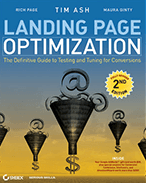The Guide to Optimizing Ads on Your Website to Make More Money (Without Annoying Your Visitors)
Last updated |
Let’s face it. Website ads have shown a real resurgence lately, with more and more online businesses using ads to generate additional revenue (even Amazon.com now has ads) or to promote content or products on their own website. A huge amount of money is spent on these ads (according to Jupiter Research $34.5 billion will be spent on this in 2012).
Unfortunately though little time and effort is spent on optimizing these ads. This is crazy when you consider that just making some small changes to optimize these ads on your website can have great influence on the amount of engagement or revenue generated from them. If you optimize the ads on your website well, you can add some amazing revenue to your bottom line.
And if you don’t optimize them, you can seriously annoy your visitors with poor ad choices and damage the chances of them converting for your goals or generating ad revenue from them, and also reduce the chances of them coming back again.
To help you with this, I have put together a guide for optimizing and making more money from your website ads. Let’s get started!
1: Test the Type of Ads Used
The first thing you need to do is test the type of ads that you use on your website, because that can have a huge impact on your revenue and your visitors.
Ads types to avoid: Some of the ads that make the most money unfortunately annoy your visitors the most, so first we will review some of the types of ad to avoid.
- Interstitial ads. These whole page interstitial ads appear as the visitor clicks between pages. These often cause high exit rates, and have a negative impact on your visitor’s perception of your website. Particularly bad are when these are shown upon entry, or can’t be skipped or closed easily.
- Pull-down/push-down ads. These interactive ads pull down over content or move content down (see example below). These often frustrate visitors by causing them to click on the wrong thing when the ad is moving, or accidentally on the ad. Particularly bad when they cover or push down key navigation menus.
- Pop-up ads. These are the subject of much debate. Unfortunately most usage of these distracts the user from what they are trying to do and annoys them. Particularly bad are ones that are hard to close. Only use these for your most important conversion goals, and avoid them on ecommerce sites (however, they can work well on lead generation websites). Personally I prefer less intrusive ads like persistent top or bottom rail ads.
- Auto-play video/audio ads. These can be VERY annoying to your visitor, particularly if the visitor doesn’t know where the sound is coming from. Always make sure a visitor can easily see how to turn these off.
Ad types to try instead: Here are some types of ad that you should testing using that will increase your revenue, while not annoying your visitors too much:
- Contextual text ads. These ads can often work well, and can actually provide value to visitors if they can’t find what they are looking for on your website. Google Adense is still the dominant player here – you can also try using other pop-up text link ads from Kontera.com.
- Interactive/rich media ads. If the ads you use on your website are intriguing to interact with, this will increase click rates on them. Making them interactive and fun is a great way to build engagement and revenue (see example of this in Burger King ad below).
- Background ads. These ads form the whole of a website background, and if done well and in good context can complement your website design, and not annoy your visitors too much. You can often charge a great premium for offering this type of advertising too.
- Sponsored content. Instead of showing traditional ads, another alternative is to get some of your website content sponsored by other companies, where their name and logo is clearly shown on each sponsored page. TV programs do this with great effect now too.
2: Test the Locations of Your Ads
To increase engagement and revenue generated from your ads, here are some tips to optimize the location of your ads:
- Test different ad spots on your pages. Don’t just presume ads should go in standard spots like your header and side bars – so test different places until you find the most influential ones (but don’t give them too much prominence over your website content though!)
- Don’t put too many ads on each of your pages. If you use more than 2 ads per page it can make your page look too crammed and cheapen your website by making it look like a banner farm. Go for quality, not quantity – test removing one of the least influential areas.
- Test removing the large leaderboard ad on your homepage. This will help improve the first impression that visitors have of your website (they often judge it by the homepage), and reduce the chances of them bouncing prematurely. The loss in revenue will often be made up for by the extra ads seen on interior pages.
- Never put ads in your shopping cart. This is huge mistake – ads on shopping carts distract and drive your visitor away at the worst moment. The only types of promotion you should be showing on shopping carts are risk reducers, like offers for free shipping or your guarantee.
- Don’t put ads next to your important calls-to-action. Always keep your ads away from your call-to-action buttons – this is because they will distract your visitors and reduce the chances of them clicking on your call-to-action and influencing them to convert for your website goals.
3: Test the Contents of Your Promotional Ads
If you are using ads to promote content/products on your own website, it’s vital that you do A/B testing in them to find versions of ads that engage your visitors the most, and cause the highest lift in conversions. Here are some things that you should test in them:
- Test your call-to-action in them. This often has the biggest impact on engagement – test the size of buttons and links you use in them, the wording of them, and the color and also the style of them – beveled, shadow etc. And avoid using ‘click here’ at all costs!
- Test your headlines and text in them. This is also very important to influence your visitors better. Test the wording, tone, voice of your text, in addition to length of the text. Test also using risk reducers to increase engagement (like free shipping or free trial).
- Test the style of them. Different colors, themes and styles of ads can all have a big impact on ad engagement. Always test creating a few radically different versions to increase your chances of much higher click rates.
- Test people used in them. Depending on who they are and what they are doing, people in ads can have a big impact on engagement and clicks on them, in particular the gender/race/age of them, and what they are doing/looking at.
- Test using videos in them. Short videos can be highly engaging in ads if they are well created and are contextual to the contents of the website, so you should try testing these (avoid using autoplay though).
- Test using animation versus static ads. Test both types – don’t presume one works better than the other, it will depend on the nature of your website. Don’t make animation too annoying though, as they can distract from your important call to actions.
4: Use Targeting in Your Ads
Think about it. If you see an ad that is more relevant to you and your interests, you are more likely to click on it, right? So rather than just using generic ads on your website that aim to engage ALL of your visitors with the same ad version, you should use targeting to show more contextual ads to different groups of visitors, so that it matches their needs better. This applies to regular ads shown on your website, and for ads that are promoting your own content.
Here are some ideas of what you can target in your ads:
- Target your visitors with ads relating to content or products they have seen most frequently on your website.
- Target your visitors with ads for other websites they have most often previously visited (this is called ad re-targeting, and you can also re-target your previous visitors when they are on other websites with ads for your website).
- Target your visitors with local ad variations relating to their geographic region (using IP address).
- Target your visitors with ads related to their search engine queries (or their internal search queries).
If you are using an ad network on your website to show ads, make sure they offer this targeting capability – ideally you should use a network like adroll.com or adretargeting.com that specializes in this. To add targeting to your own promotional ads, you can use any advanced testing tool like Adobe Test&Target.
So there we have it. Basically it’s all about testing and optimizing your current usage of them to make more money. This is just one of the types of page elements that I review and offer best practices and test ideas for in my new book, along with many others like call-to-actions, images, navigation menus, videos and forms. Have you read it yet?







